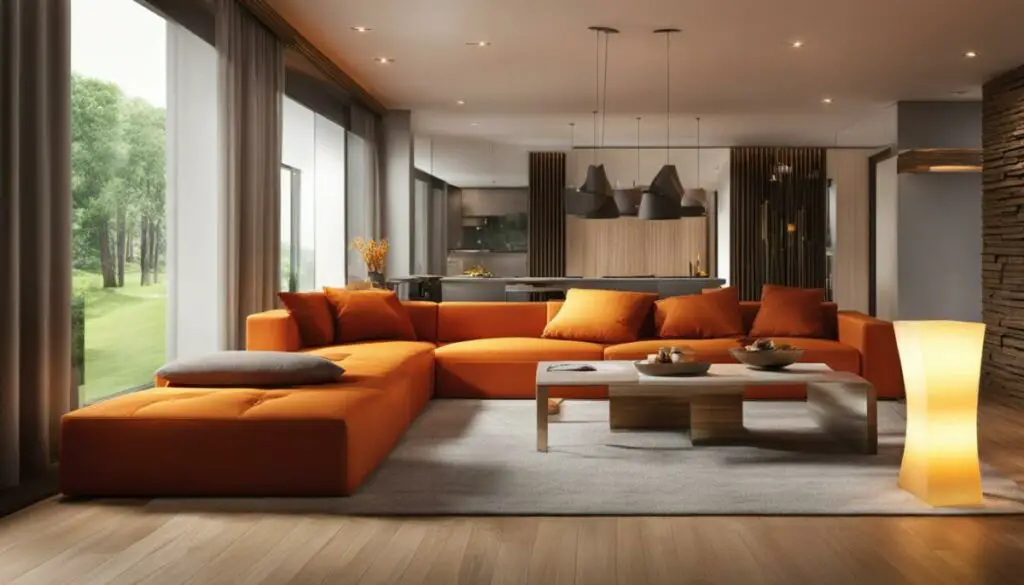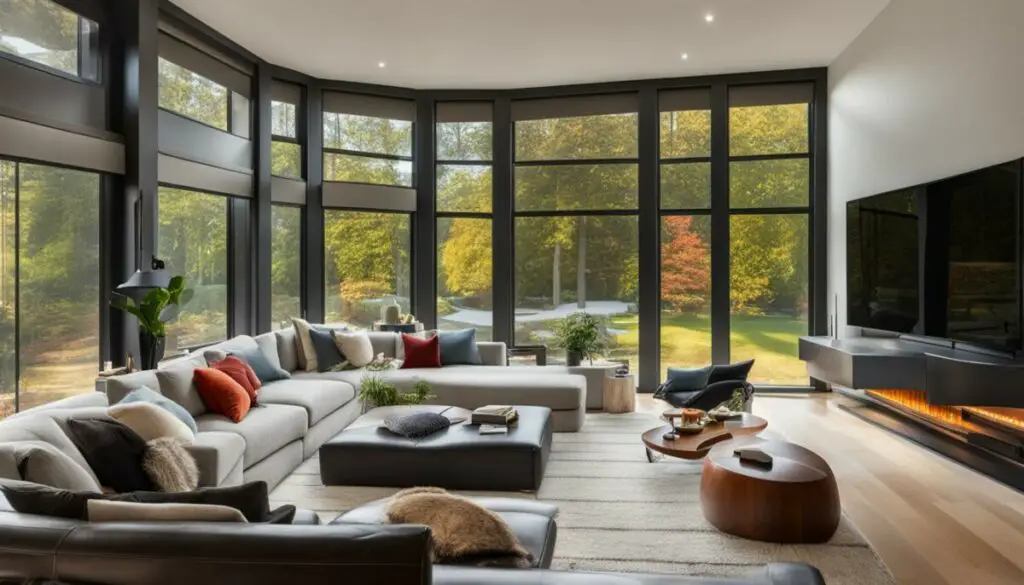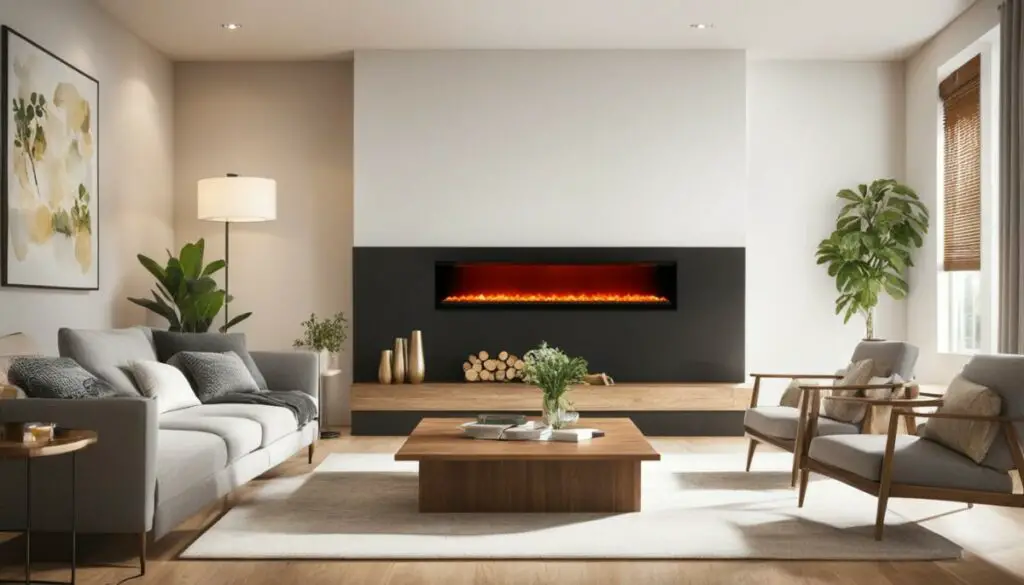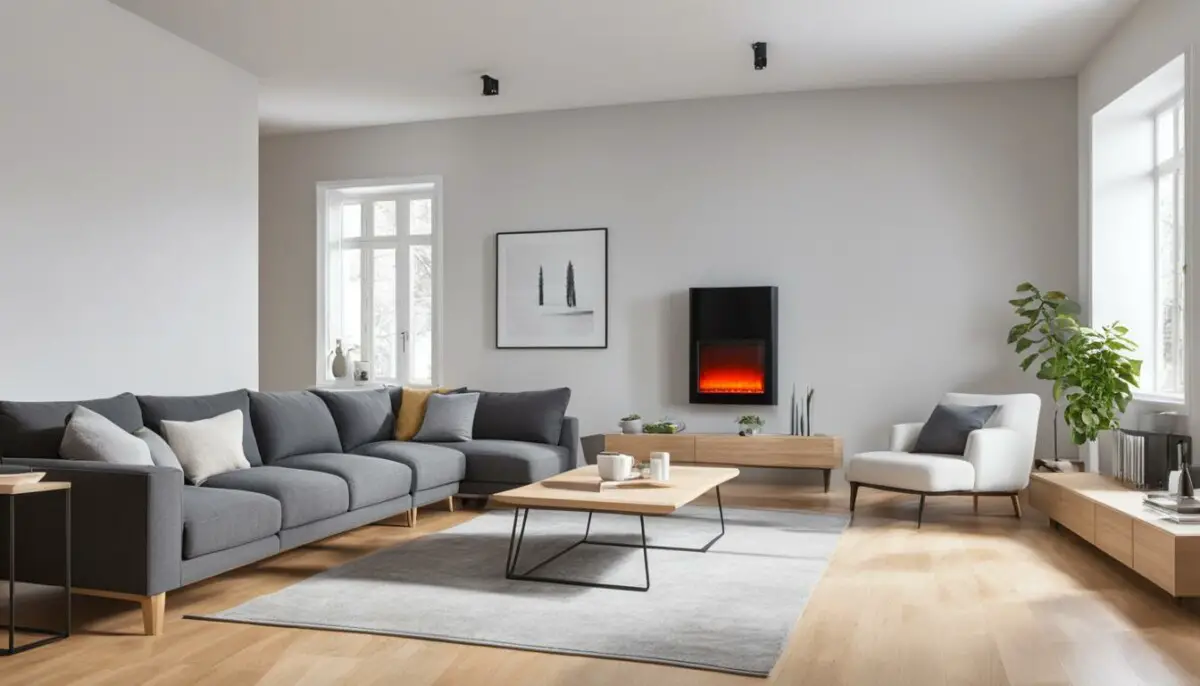Last Updated on 4 months by Francis
When it comes to heating our homes, we often rely on central heating systems to keep us warm and comfortable. But what about the newer technology of infrared heating? Can an infrared heater heat a whole house just as effectively? Let’s explore this question and compare infrared heaters to traditional central heating systems.
Infrared heating works by emitting infrared radiation that directly heats objects in a room, rather than warming the air like central heating systems. Electric infrared heating, particularly far infrared heaters, have gained attention for their efficiency. These heaters emit a majority of their heat as infrared radiation, making them more energy-efficient compared to traditional heating methods.
However, there are some considerations to keep in mind when it comes to infrared heating. While it may require less overall energy since it only heats the objects that need heating, there can be potential issues with dampness and mold due to reduced overall heat demand. Additionally, obstacles in a room can create heat shadows, meaning that some areas may not receive the same level of warmth.
On the other hand, central heating systems, such as heat pumps, are considered a more cost-effective and carbon-friendly option. They provide efficient heating for the entire house with less risk of dampness and mold. Heat pumps also have a higher efficiency, producing more units of heat for each unit of electricity consumed.
Contents
Key Takeaways:
- Infrared heaters emit infrared radiation that directly heats objects, rather than warming the air like central heating systems.
- Electric infrared heating, particularly far infrared heaters, is known for its energy efficiency.
- Potential issues with infrared heating include dampness, mold, and heat shadows caused by obstacles in a room.
- Heat pumps are a more cost-effective and carbon-friendly option for whole house heating.
- Consider the specific heating needs and requirements of your space before choosing the most suitable heating option.
What is Infrared Heating?

Infrared heating is a unique method of heating that utilizes infrared radiation instead of traditional convection heating, which heats the air. Rather than warming the air around it, infrared radiation directly heats objects in its path, leaving the air relatively cold. This groundbreaking approach to heating has gained significant popularity in recent years, especially with the introduction of electric infrared heating, specifically far infrared heaters.
Far infrared heaters have become the go-to choice for efficient and effective heating solutions. These heaters emit a majority of their heat as infrared radiation, making them highly efficient in providing warmth. In fact, the efficiency of electric infrared heating can reach up to 100%, ensuring that you get the most out of every unit of energy consumed.
By harnessing infrared radiation, electric infrared heaters offer several advantages over traditional heating methods. Not only do they produce heat more efficiently, but they also provide a more comfortable warmth that is absorbed by objects and individuals within the space. This direct heating mechanism eliminates the need for long warm-up times and reduces energy wastage. As a result, electric infrared heating is not only effective but also cost-effective in the long run.
Moreover, electric infrared heating can be tailored to suit different requirements and spaces. Whether you need to heat a small room, an entire house, or a large open-plan area, there is an infrared heating solution that can meet your needs. The flexibility and versatility of electric infrared heaters make them an excellent choice for both residential and commercial spaces.
So, if you’re looking for an innovative and efficient heating option, consider embracing the power of infrared heating. With its ability to directly heat objects, electric infrared heating provides exceptional comfort, energy savings, and adaptability for a wide range of applications.
Benefits and Issues of Infrared Heating

When it comes to heating, infrared heating offers several notable benefits. One of the primary advantages is its potential for energy savings. Unlike traditional heating methods that warm the air, infrared heating directly heats objects. This targeted approach means that only the objects that need heating receive warmth, resulting in reduced energy consumption and lower utility bills.
However, there are some issues associated with infrared heating that need to be considered. One of these concerns is the potential for increased dampness and mold in the building. Because infrared heating reduces the overall heat demand, there may not be enough warmth in the surrounding air to combat moisture buildup effectively. As a result, dampness and mold can become a problem.
Another issue relates to comfort. With infrared heating, only objects that are directly hit by the infrared radiation will get warm. This means that if you are not within the direct line of the infrared rays, you may not experience the same level of comfort. There is limited research on the comfort aspects of infrared heating, so it’s important to consider this potential drawback.
It’s worth noting that heat pumps offer an alternative heating solution that addresses some of the issues associated with infrared heating. Heat pumps are known for their efficiency and cost-effectiveness. They work by extracting heat from outside sources and transferring it into the building, providing consistent and comfortable warmth throughout the space.
| Benefits of Infrared Heating | Issues with Infrared Heating |
|---|---|
|
|
“Infrared heating offers targeted warmth and energy savings, but it’s important to consider the potential for increased dampness and comfort issues. Heat pumps provide an efficient alternative for consistent and cost-effective heating.” – Sarah Smith, HVAC Specialist
Comparing Infrared Heating to Other Options

When it comes to heating large homes, it’s essential to explore multiple options, including heat pumps and resistive heating systems like infrared heaters. Each option has its pros and cons, which we will delve into in this section.
The Efficiency Factor
Heat pumps may have a higher initial investment cost compared to infrared heaters, but they offer higher efficiency levels. Heat pumps produce 3 to 4 units of heat for every unit of electricity consumed, making them a more energy-efficient choice for heating large spaces. On the other hand, resistive heating systems like infrared heaters do not provide this level of efficiency.
Carbon Intensity
When it comes to carbon emissions, heat pumps are the more sustainable choice. They have a lower carbon intensity compared to resistive heating systems. By utilizing renewable energy sources, heat pumps contribute less to carbon emissions, making them an environmentally friendly heating option.
Cost-Effectiveness for Large Homes
For large homes, heat pumps offer a more cost-effective long-term solution. Despite their higher upfront cost, heat pumps offset this through their energy efficiency, resulting in lower energy bills in the long run. In contrast, resistive heating systems like infrared heaters may have a lower initial cost but can lead to higher energy expenses due to their lower efficiency.
Ultimately, the choice between heat pumps and infrared heaters depends on your priorities. If energy efficiency and long-term cost savings are crucial, heat pumps are the preferred option. However, if upfront cost is a significant factor, infrared heaters may be a more budget-friendly choice. Assessing your specific needs and considering factors such as efficiency, carbon intensity, and long-term costs will help you make an informed decision for heating your large home.
| Factors | Heat Pumps | Infrared Heaters |
|---|---|---|
| Efficiency | High (3-4 units of heat per unit of electricity) | Lower efficiency compared to heat pumps |
| Carbon Intensity | Lower carbon emissions | Higher carbon intensity |
| Cost-Effectiveness | Higher upfront cost, lower long-term energy expenses | Lower upfront cost, potentially higher long-term energy expenses |
Heating Options for Different Spaces

When it comes to heating different spaces, infrared heating offers a range of options to suit various needs. Whether you’re looking to heat an entire house, a large open-plan space, or the outdoors, there’s an infrared heater that can meet your requirements.
If you’re seeking to heat your entire house, far infrared heaters are an excellent choice. These heaters emit a subtle warmth that penetrates deeper into objects, providing consistent and comfortable heating throughout the entire space. With their energy-efficient operation, far infrared heaters can help you create a cozy and inviting home environment.
For larger spaces like warehouses and workshops, ceramic heaters with longwave infrared are the ideal solution. These heaters deliver powerful heat that can effectively warm expansive areas, ensuring that everyone in the space feels comfortable and productive.
Infrared heating is not limited to indoor spaces. If you’re looking to heat outdoor areas such as patio or garden spaces, near infrared heaters, also known as shortwave infrared heaters, are a great option. These heaters produce intense heat that can quickly warm up your outdoor environment, providing a cozy atmosphere for outdoor entertaining or relaxation.
To give you a clearer picture of the heating options for different spaces, here’s a comparison table:
| Space | Recommended Infrared Heater |
|---|---|
| Entire House | Far Infrared Heaters |
| Large, open-plan spaces (warehouses, workshops) | Ceramic Heaters with Longwave Infrared |
| Outdoor spaces (patios, gardens) | Near Infrared (Shortwave Infrared) Heaters |
By choosing the right infrared heater for your space, you can enjoy efficient and effective heating that matches your specific needs. Whether you’re heating a small room or a large outdoor area, infrared heating provides versatile solutions that combine comfort and energy efficiency.
Infrared Heating for an Entire House
Infrared heating is an excellent option for heating an entire house, offering a comfortable and efficient solution. Far infrared heaters are specifically designed to emit infrared radiation that heats objects and surfaces, providing a feeling of warmth similar to natural sunlight. This type of heating is particularly beneficial for large spaces, as it ensures even heating throughout the entire house and eliminates cold spots.
The best infrared heater for large spaces will depend on factors such as the size and layout of your house, as well as your specific heating requirements. It’s important to consider the wattage and coverage area of the heater to ensure it can effectively heat your entire house.
When choosing an infrared heater for your whole house, look for features such as adjustable thermostat settings, programmable timers, and safety features like overheat protection. These additional features can enhance the convenience and safety of your heating system.
Stylish and Efficient Infrared Heating Solutions

Infrared heaters offer a combination of style and efficiency, making them a popular choice for modern homes. With sleek designs and innovative technology, these heaters not only provide effective heating solutions but also enhance the overall aesthetic appeal of the space.
“Infrared heating panels, such as the Ecostrad Accent range, are a perfect example of stylish and efficient heating solutions. These panels offer a low-energy consumption option that can be easily mounted on the ceiling or wall. They provide comfortable and consistent heat distribution, ensuring a cozy environment in any room.”
Efficient Heating with Infrared Panels
Infrared panels are a popular choice for homeowners looking for efficient heating solutions. These panels emit infrared radiation, which heats objects and surfaces directly, resulting in a more comfortable and energy-efficient heating experience. The Ecostrad Accent range is designed to offer optimal performance while consuming minimal energy. With their high energy conversion efficiency, these infrared panels provide sustainable heating solutions for various spaces in your home.
| Key Features of Infrared Panels | Benefits |
|---|---|
| Low-energy consumption | Reduces electricity costs |
| Easy ceiling or wall mounting | Offers flexible installation options |
| Comfortable and consistent heat distribution | Provides an even warmth throughout the room |
| Stylish and sleek design | Enhances the aesthetic appeal of the space |
Mirror Panels for Bathrooms and Kitchens
Mirror panels are not only functional but also serve as efficient heating solutions for bathrooms and kitchens. These panels provide both heat and prevent condensation on the mirror surface, ensuring clear visibility even in steamy environments. The mirror panels, such as the Ecostrad Tropic range, combine style and practicality, making them an ideal choice for these spaces.
Portable Infrared Panels for Convenience
If you’re looking for heating solutions that can be used in different rooms as needed, portable infrared panels are the perfect option. These panels offer the flexibility to move them to various areas of your home, providing warmth wherever it’s required. With their compact size and lightweight design, portable infrared panels offer convenience without compromising on heating efficiency.
- Easy to carry and transport
- Can be used in bedrooms, living rooms, or home offices
- Quick and hassle-free installation
With stylish infrared heaters like infrared panels, mirror panels, and portable infrared panels, you can enjoy efficient heating solutions that not only keep your home warm and cozy but also add a touch of elegance to your living space.
Extending Infrared Heating to the Outdoors

Infrared heating is not limited to indoor spaces; it can also be extended to outdoor areas. Whether you want to keep your garden cozy on cooler evenings or create a warm and inviting atmosphere on your patio, outdoor heating solutions are available to meet your needs. Patio heaters, specifically designed for outdoor use, are an excellent choice for extending the comfort of infrared heating outside.
One popular option for outdoor heating is the Ecostrad Solaglo patio heater. This weatherproof heater utilizes shortwave infrared technology to provide instant and consistent warmth, ensuring a comfortable outdoor experience. With its low-glare gold bulb, the Solaglo creates a relaxing ambiance without causing discomfort from excessive brightness.
The Ecostrad Solaglo patio heater is designed with durability in mind. Its weatherproof rating ensures it can withstand various weather conditions, making it suitable for year-round outdoor use. You can choose to mount it on the wall or ceiling, providing flexibility in installation and maximizing space utilization.
Experience the benefits of infrared heating in your outdoor spaces with the Ecostrad Solaglo patio heater. Whether you’re hosting a gathering on your garden or enjoying a quiet evening on your patio, this weatherproof infrared heater will keep you warm and comfortable.
Make the most of your outdoor areas with the Ecostrad Solaglo patio heater.
Testimonials and Case Studies
Infrared heating solutions have garnered positive feedback from satisfied customers who have experienced the numerous benefits of these innovative systems. From efficient and comfortable warmth to cost savings and improved heating performance, infrared panels have proven to be an excellent choice for heating homes. Let’s take a closer look at some customer testimonials and case studies.
Customer Testimonials
“We installed infrared panels in our home, and we have been amazed at how quickly and evenly the heat spreads throughout the room. It’s incredibly efficient, and we no longer have to deal with cold spots or excessive energy bills.” – Sarah H.
“I suffer from allergies, and traditional heating systems always aggravated my symptoms. Since switching to infrared heating, I’ve noticed a significant improvement in my respiratory health. The infrared panels provide a gentle and clean heat that doesn’t affect the air quality negatively.” – Michael K.
“After years of struggling with an outdated heating system, we decided to invest in infrared panels for our home. The difference has been remarkable. Not only do we enjoy a cozy and consistent warmth, but our energy bills have also significantly decreased. It’s a win-win!” – Emily T.
Case Studies
Case studies further highlight the effectiveness of infrared heaters in replacing outdated heating systems and delivering exceptional results. Let’s explore a couple of real-life examples:
Case Study 1: Retrofitting a Victorian Home
| Challenge | Solution | Outcome |
|---|---|---|
| The homeowner desired a more efficient and cost-effective heating solution for their large Victorian home. | Installed infrared panels throughout the house and integrated smart thermostats for precise temperature control. | Reduced energy consumption by 30%, resulting in substantial cost savings. The infrared panels provided a consistent and comfortable warmth, eliminating cold spots and drafts. |
Case Study 2: Warehouse Heating
| Challenge | Solution | Outcome |
|---|---|---|
| A warehouse required an efficient heating solution for its large, open-plan space. | Installed ceramic heaters with longwave infrared to effectively heat the expansive area. | Improved heating performance and comfort within the warehouse, ensuring optimal working conditions for employees during colder months. |
These case studies exemplify how infrared heating solutions have transformed homes and businesses, providing energy-efficient and reliable warmth.
Conclusion
After considering the various factors, it is clear that while infrared heating can effectively heat a whole house, there are important aspects to take into account. Increased dampness and potential comfort issues can arise with this type of heating. On the other hand, heat pumps offer a more cost-effective and environmentally friendly solution.
However, it is important to note that infrared heaters do have their own advantages. They provide stylish designs and offer efficient heating solutions for different spaces within the home, both indoors and outdoors. Whether it’s a ceiling-mounted infrared panel or a portable option, there are versatile choices available to suit specific needs.
Ultimately, when choosing a heating option, it is crucial to assess the specific requirements and heating needs of the space in question. This will ensure that the most suitable heating solution is selected, taking into consideration both cost-effectiveness and carbon-friendly factors.
FAQ
Can an infrared heater heat a whole house?
Yes, infrared heaters can heat a whole house. However, it is important to consider factors such as increased dampness and comfort issues.
What is infrared heating?
Infrared heating involves the emission of infrared radiation that directly heats objects instead of heating the air. Electric infrared heating, specifically far infrared heaters, are gaining popularity.
What are the benefits and issues of infrared heating?
The benefits of infrared heating include potential energy savings and efficient heating of specific objects. However, there can be issues with increased dampness and comfort limitations.
How does infrared heating compare to other options?
Heat pumps are considered a more cost-effective and carbon-friendly option compared to infrared heating. Resistive heating systems, like infrared heaters, have higher carbon intensity.
What are the heating options for different spaces?
Infrared heaters offer a variety of options for different spaces, including far infrared heaters for heating the entire house and ceramic heaters for larger open-plan spaces.
What are the stylish and efficient infrared heating solutions?
Infrared panels, mirror panels, and portable infrared panels offer stylish and energy-efficient heating solutions for various spaces in the home.
Can infrared heating be extended to the outdoors?
Yes, infrared heating can be extended to outdoor spaces with the use of patio heaters that provide instant and consistent warmth.
Are there testimonials and case studies for infrared heating?
Yes, there are testimonials and case studies that highlight the efficient and comfortable warmth provided by infrared heaters in homes.
What is the conclusion about infrared heating?
Infrared heating is a cost-effective and efficient heating solution, but it is important to consider the specific needs and requirements of the space before choosing the most suitable option.


.jpg)


.jpg)


